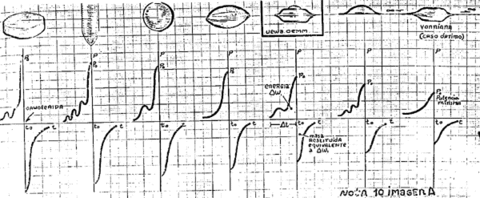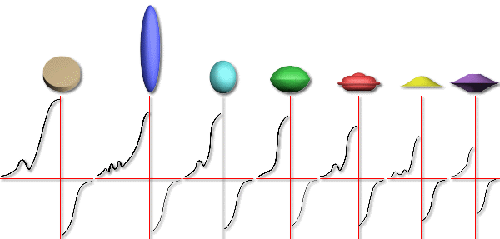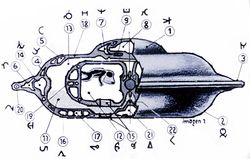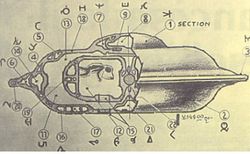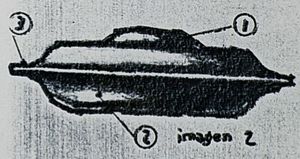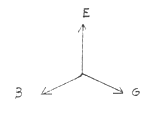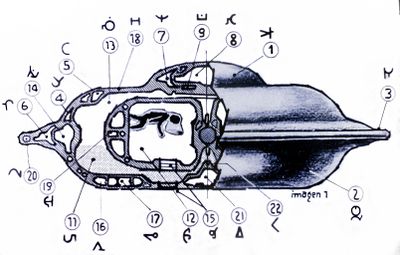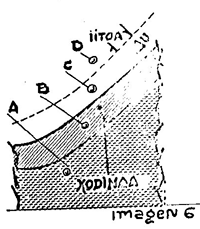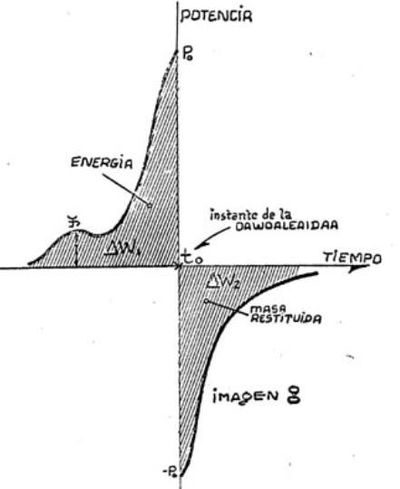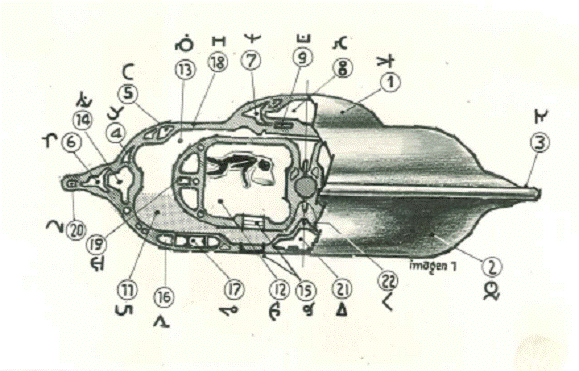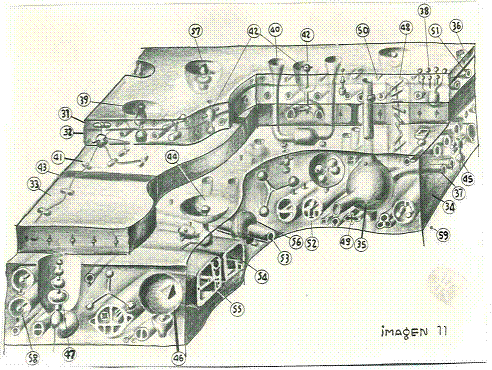OOMO SPATIAL VESSELS : Différence entre versions
(→Possible models) |
|||
| Ligne 2 : | Ligne 2 : | ||
whose phonetic roots: '''[[OAWOO]]''' = dimension; '''OOLEEA''' = to penetrate, to pierce; '''UEWAA'' (OOEWA in English) = vehicle, vessel; '''OEMM''' = between the stars; sidereal; of spherical mass; with spherical mass (D69-2). | whose phonetic roots: '''[[OAWOO]]''' = dimension; '''OOLEEA''' = to penetrate, to pierce; '''UEWAA'' (OOEWA in English) = vehicle, vessel; '''OEMM''' = between the stars; sidereal; of spherical mass; with spherical mass (D69-2). | ||
| − | The whole letter in | + | ''The whole letter in english is on [[Ummo texts corpus]] "D69-ENGLISH"'' |
== Other spellings == | == Other spellings == | ||
| Ligne 37 : | Ligne 37 : | ||
[[Fichier:Nef-ultimeXX400.jpg|250px]][[Fichier:Ummof14g.jpg|250px]] | [[Fichier:Nef-ultimeXX400.jpg|250px]][[Fichier:Ummof14g.jpg|250px]] | ||
| − | {{ | + | {{Lettre|D21| |
The disclosable characteristics, those not subject to our safety standards, of our '''OAWOOLEA UEWA''' are : | The disclosable characteristics, those not subject to our safety standards, of our '''OAWOOLEA UEWA''' are : | ||
| Ligne 52 : | Ligne 52 : | ||
===Exterior view=== | ===Exterior view=== | ||
[[File:D69-2.jpg|300px|thumb|Three clearly differentiated parts]] | [[File:D69-2.jpg|300px|thumb|Three clearly differentiated parts]] | ||
| − | {{ | + | {{Lettre|D69-1|An outside observer will distinguish three clearly differentiated parts: (IMAGE 2) |
:[2] [[ENNAEOI]] (CENTRAL BODY OF THE SUPERSTRUCTURE) | :[2] [[ENNAEOI]] (CENTRAL BODY OF THE SUPERSTRUCTURE) | ||
:[1] [[ENNOI]] (SORT OF TOWER OR DOME) | :[1] [[ENNOI]] (SORT OF TOWER OR DOME) | ||
| Ligne 58 : | Ligne 58 : | ||
=== Systems and equipment considered as networks (AYUU)=== | === Systems and equipment considered as networks (AYUU)=== | ||
| − | {{ | + | {{Lettre|D69-1|All the auxiliary equipment of the''''UEWA'''' is regulated within an [[AYUU]] (NETWORKS) and under the control of an [[XAANMOO]] (Equipment that performs functions similar to those of an EARTHLY electronic computer, [... and these] decisions can be modified in extreme cases by crew members.}} |
=== Crew === | === Crew === | ||
| − | {{ | + | {{Lettre|D57-1|twenty-four men set out for this Planetary System in two OAUOLEEA UEUA OEMM}} |
The crew of an OAUOLEEA UEUA OEMM must therefore be made up of 12 oemmii (as 24 divided by 2 equals 12). | The crew of an OAUOLEEA UEUA OEMM must therefore be made up of 12 oemmii (as 24 divided by 2 equals 12). | ||
| Ligne 83 : | Ligne 83 : | ||
===Propulsion (IDUUWII AYII)=== | ===Propulsion (IDUUWII AYII)=== | ||
| − | {{ | + | {{Lettre|D57-3| |
Another easily observable feature is the very strong magnetic field that appears around the axis of symmetry of our spaceships, (and perhaps also in other spaceships belonging to other extraterrestrial beings). This magnetic field, which reaches many thousands of Webber / metre<sup>2</sup>, is not, as one might imagine, a clue to the fact that our propulsion system is magnetodynamic. This strong magnetic induction is merely the axial inversion, by an angle of 90°, of the electrostatic field intensity produced by a powerful generator whose function is to invert the subatomic particles of the ship and its passengers (Remember that the vectors representing the gravitational, electrostatic and magnetic fields form a trihedron within multidimensional space. All three fields are in fact identical. It's our illusory physiological perception that attributes a different nature to them depending on their orientation). | Another easily observable feature is the very strong magnetic field that appears around the axis of symmetry of our spaceships, (and perhaps also in other spaceships belonging to other extraterrestrial beings). This magnetic field, which reaches many thousands of Webber / metre<sup>2</sup>, is not, as one might imagine, a clue to the fact that our propulsion system is magnetodynamic. This strong magnetic induction is merely the axial inversion, by an angle of 90°, of the electrostatic field intensity produced by a powerful generator whose function is to invert the subatomic particles of the ship and its passengers (Remember that the vectors representing the gravitational, electrostatic and magnetic fields form a trihedron within multidimensional space. All three fields are in fact identical. It's our illusory physiological perception that attributes a different nature to them depending on their orientation). | ||
| Ligne 93 : | Ligne 93 : | ||
| − | {{ | + | {{Lettre|D69-2|With regard to the technique we use for the [[inversion]] of all atomic subparticles included in the geometric enclosure of l''''UEWA''', we take the liberty of ''omitting'' any information likely to be immediately applied by your terrestrial physicists and engineers. I must also ''censor'' the transmission of documents (albeit merely indicative) concerning the scientific bases of their application to the ''propulsion'' system of our vessels. |
In this case, then, I can only offer a purely topographical description of the location of the corresponding equipment. | In this case, then, I can only offer a purely topographical description of the location of the corresponding equipment. | ||
| Ligne 112 : | Ligne 112 : | ||
===Particle inversion (IBOZOOAIDAA)=== | ===Particle inversion (IBOZOOAIDAA)=== | ||
| − | {{ | + | {{Lettre|D69-2| |
[[File:Nef-ultimeXX.jpg|thumb|center|400px|<center>Image 1</center>]] | [[File:Nef-ultimeXX.jpg|thumb|center|400px|<center>Image 1</center>]] | ||
Version du 16 mai 2024 à 09:27
'OAWOOLEA UEWA OEMM (SPATIAL VESSELS),
whose phonetic roots: OAWOO' = dimension; OOLEEA = to penetrate, to pierce; UEWAA (OOEWA in English) = vehicle, vessel; OEMM = between the stars; sidereal; of spherical mass; with spherical mass (D69-2).
The whole letter in english is on Ummo texts corpus "D69-ENGLISH"
Sommaire
Other spellings
- OAUOLEA UEUA OEMM (SPACE SHIPS) || 57-2
- OUEWA (space vehicles) || NR-18 (French spelling, the U becomes OU)
- OAWOLEA OUEWA (lenticular spaceship) || D84
- OAWOLEA UEWA (NAVES) || D63
- OAWOLEA UEWA (ships) || 57-3
- OAWOOLEA UEUA (vessels) || D83
- OAWOOLEA UEUAA (Flying disks as you call them) || D23
- OAWOOLEA UEWA (cosmonefs) || D41-6
- OAWOOLEA UEWA (lenticular structure ships) || 57-5
- OAWOOLEA OUEWA OEM (spacecraft) || NR-20
- OAWOLEA UEWA OEM (lenticular spacecraft) || D74
- OAWOOLEA UEWA OEM (what you call O.V.N.I. or Flying Saucers) || D21
- OAUOLEAA UEWAA OENMM (interastral travel vessels) || D1378
- OAUOLEEA UEUA OEMM (lenticular vehicles traveling outside our atmosphere) || D57-1
- OAUOOELEA UEUA OEMM (lenticular NEFS for Galactic travel) || 57-3
- OAWOOLEA UEUA OEEMM (ASTRONEF) || D60
- OAWOOLEA UEUA OEEMM (lenticular vessel) || 57-4
- OAWOOLEA UEWA OEMM (spaceships) || D37-2
- OAWOOLEA UEWA OEMM (LENTICULAR NAVE FOR INTRAGALACTIC TRAVEL) || D59-1
- OAWOOLEA UEWA OEMM (spacecraft) || D41-16
- OAWOOLEA UEWA OEMM (disc-shaped spaceships) || D45
- OAWOOLEA UEWA OEMM (spacecraft) || 57-3
Possible models
13-meter Ummite model
The disclosable characteristics, those not subject to our safety standards, of our OAWOOLEA UEWA are :
Circular base with outer diameter of 7.1 Enmoo (some 13.18 metres).
Cross-section, pseudo-lenticular, approximately 3.25 meters high.
Three extendable legs with rectangular support panels.
The magnetic disturbances recorded by Soviet engineer Alexei Krylov, are not due to the fact that the very nature of the propulsion is magnetism. The high induction observed, 10 meters from its "center of inertia" and frequently reaching 4600 gauss, is due to a secondary effectAccording to these data and the drawings the habitable part would have the following characteristics: the floor circumference would be about 19 ml, the ceiling height about 2.3 m, the surface area about 40 m2, and the volume about 90 m3
Exterior view
Systems and equipment considered as networks (AYUU)
Crew
The crew of an OAUOLEEA UEUA OEMM must therefore be made up of 12 oemmii (as 24 divided by 2 equals 12).
Ratio oummain
Reading the http://ummo-sciences.org/fr/D69-1.htm series is essential. It's a very long document, 41 pages long, with many drawings and symbols.
The notes are as important (if not more so) than the text itself, and for this reason are presented "en regard", on the right-hand side, along with the images. Some of them are replicated.
Index
This document is presented in five "pages" (from D69-1 to D69-5). The links at the bottom of the pages allow you to follow the reading. The chapters are divided into pages as follows:
- 69-1 : Introduction / Outline and details of the'UEWA' / Structure of the'UEWA / TheENNAOEII (central body) - Note 6 / Systems and equipment - Note 1 and 2 /
- 69-2 : Propulsion (IDUUWII AYII) / Particle inversion (IBOZOOAIDAA) / Crew enclosure / Float phase (OEE) / Travel phase (AGOIA)
- 69-3 : Structural lining (XOODI NAA) - Note 15, 3 - 4 - 7 - 19
- 69-4: The core: transceiver by gravitational waves (UAXOO AXOO) / Sidereal and atmospheric navigation - Notes 5 - 10 -11
http://ummo-sciences.org/fr/D69-5.htm 69-5] :Explanations of apparent UFO behavior / Disappearance of ship / Sudden changes in speed - Note 12 / End of letter . Notes 8, 9, 13, 14, 16 and 17 are missing or later censored by the Ummites.
In particular
Propulsion (IDUUWII AYII)
Another easily observable feature is the very strong magnetic field that appears around the axis of symmetry of our spaceships, (and perhaps also in other spaceships belonging to other extraterrestrial beings). This magnetic field, which reaches many thousands of Webber / metre2, is not, as one might imagine, a clue to the fact that our propulsion system is magnetodynamic. This strong magnetic induction is merely the axial inversion, by an angle of 90°, of the electrostatic field intensity produced by a powerful generator whose function is to invert the subatomic particles of the ship and its passengers (Remember that the vectors representing the gravitational, electrostatic and magnetic fields form a trihedron within multidimensional space. All three fields are in fact identical. It's our illusory physiological perception that attributes a different nature to them depending on their orientation).
In this case, then, I can only offer a purely topographical description of the location of the corresponding equipment.
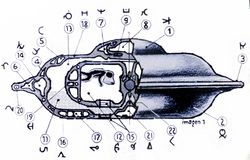
The IDUUWII AYII equipment ('propulsion) is distributed inside a toroid of revolution assembled (stamped) inside the DUII, fin or crown [...] which surrounds the vessel on its central plane.
The energy source is located in the ENNOI (turret or cupola). This energy generator also has a toroidal morphology. Its most characteristic feature is a lattice of highly ionized gas whose circulation is controlled by a complex, very high-frequency magnetic field (in this case, I use the word "lattice" as a synonym for Network or Spatial Grid). The temperature of the ionized gas when in resonance with the frequency of the magnetic environment reaches 0.7.106 Kelvin grades [...].
Propulsion control is highly complex: steering, cruising speed and automatic acceleration control at any given moment depend on the XAANMOO AYUUU (central computer network). The kinematic function is a very complicated one, whose multiple corrective parameters depend, for example, on :
- 1 - what we call USAGIISOO ("isodynamic" state of cosmic space),
- 2 - the presence of intense gravitational fields,
- 3 - the threat of "COSMOLITOS" (excuse us for using our neologism, which we consider more appropriate than the term "meteorite" or "aerolith"),
- 4 - possible attacks by foreign vessels,
- 5 - space zones of ionic, electromagnetic or gravitational radiation, dangerous or disruptive to our on-board systems, etc.
Particle inversion (IBOZOOAIDAA)
IBOZOOAIDAA (particle inversion)
This equipment is present throughout the solid mass of the structure, although the control center is fixed in all our ship models in the ENNOI, a kind of cylindroid turret that crowns our ships - Image 1 - 1 ). This is perhaps, if we exclude the IDUWII AYII equipment the vital factor of our OAWOOLEA UEWA OEMM [...]
- The phoneme OOLEA [= penetrate, pierce ...] when applied to the technical field [...]: to change, pass from one physical medium to another.
In scientific language it means: to increase or decrease the value of an angle into another infinitesimal angle. [...]
The entire superstructure of the ship, as we'll explain later, is protected by a finely perforated ceramic substance, which covers the outer armour.
A safety space layer is delimited, with a thickness of ΔU = 0.0176 ENMOO [... ~33 mm]] and surrounds the entire ENMOO. We call IITOOA the ideal outer layer whose morphology is similar to that of the vessel (image 7) and which separates the enclosure from the rest of Space.

Any subatomic particle or energy "quanton" (IBOZOO UU) located inside this enclosure can be inverted in another three-dimensional system. For example (image 6): a neutron "A" corresponding to any mass inside the ship, as well as the masses of crew members, gases, ionic radiation, etc.
Thus, for example, another proton "B" belonging to the envelope or shielding, as well as all the atomic and energetic subparticles "C" of any gas molecule or cosmic dust particle contained in the thin cortical environment of thickness ΔU delimited by the IITOA, would appear to "disappear" to the view of an imaginary observer equipped with exceptional observation equipment, located outside the enclosure delimited by the ITOOA.
This instantaneous transformation we call OAWOOLEAIDAA is caused by the same IBOZOO AIDAA equipment (image 1 - 8) simultaneously reversing the oriented axes of all IBOZOO UU including those of its own structure.
I can't even hint at the technical basis of this system, the mere mention of which must be a science-fiction fantasy to your terrestrial engineers. But I can offer you a few additional facts: the energy input required for this physical transformation is very high, and is represented for our UEWA by the graphical representation of the function P = phi (t) (image 8).
The necessary energy involved up to instant t0 OAWOOLEAIDAA (the instant when all subparticles undergo their inversion) is restored in full without loss, so that ΔW1 = ΔW2, both represented by the hatched areas of the graph, and transform into the new three-dimensional frame in the form of MASS (ΔW2 represents the energy equivalent of the Mass generated). You'll understand its physical significance better if I point out that immediately after t0, in the new three-dimensional frame, the l'UEWA moves at a higher speed without the abrupt change in velocity (infinite acceleration at time t0) being acknowledged by the ship and its crew.
P0 represents the threshold power required to transform the entire mass m0 of the l'UEWA (m0 represents not the mass at absolute rest but the real mass relative to a referential system at instant t0). The limiting power P0 = phi(m0) encompasses not only the mass of l'UEWA but also those of the particles contained in the ITOOA enclosure (image 7) (read also note 10 - see page 69-5).Structure of the saucer (UEWA OEMM)
Front section (components 1-22)
1 - ENNOI: protuberance, turret or dome located in the upper hemisphere of the UEWA OEMM (its membrane is transparent).
2 - ENNAEOI: central body of the vessel's superstructure.
3 - DUII: equatorial ring or corona surrounding the 'UEWA.
4 - AAXOO XAIUU AYII: magnetic field-generating toroid.
5 - NUUYAA : toroidal tanks of hydrogen peroxide and molten lithium.
6 - IDUUWII AYII: propulsion equipment located in a ring-shaped enclosure embedded in the DUII.
7 - Power generator. Transforms the mass of Lithium and Bismuth into energy, after its conversion into plasma.
8 - IBOZOOAIDAA: central control equipment for IBOZOO UU inversion.
9 - XANMOO: autonomous peripheral computers [the central XANMOO is located (central sphere in image 1) at the geometric center of the "12" AYIYAA OAYUU. ].
10 - Censored in the copy.
11 - TAXEE: jelly or gelatinous mass (occupying the interior of the AYIYAA OAYUU in use).
12 - AAYIYAA OAYUU: floating cabin.
13 - YAAXAIIU : can be translated as "magnetic cavity".
14 - This toroidal structure houses a number of l'UEWAs equipment. Part of the magnetic field generator, the control units for the XOODINAA, food tanks and transported mobile equipment, equipment for manufacturing accessories, etc.
15 - IMMAA: some of the access hatches.
16 - YAA OOXEE: mercury tank.
17 - Complex annular enclosure located among other elements, emerging sustentation feet, element transmutators, etc.
18 - XOODINAA: membrane, bark, outer wall or armour protecting the ''UEWA. It is opaque and of great structural complexity, except for ENNOI, which is transparent and homogeneous.
19 - ?
20 - YUUXIIO: toroidal equipment for controlling the gaseous environment.
21 - UAXOO AAXOO: shielded emission and detection center.
22 - ENNOI AGIOA: dome or assembly cone. Can dissolve or regenerate under the control of the central xanmoo.
XOODI NAA structural cladding (components 31-59)
Link to larger image 1000px: https://www.ummowiki.fr/index.php/Fichier:Grande_D69-img11.gif
Link to larger image 1000px (colors reversed): https://www.ummowiki.fr/index.php/Fichier:Grande_D69-img11-invers%C3%A9.gif
31 : UOXOODINAA (UO = 0, therefore: first layer from the outside) This is a porous coating of ceramic composition with a high melting point (7260.64° C. Terrestrial); its external emissivity is also high and its thermal conductivity very low (2.07113.10-6 cal/(cm) (s) (°C).
32: IASXOODINAA (IAS = 1 => second layer from the outside) formed by a very elastic material with very low thermal and electrical conductivities. Inside are capsules [50] (YAAEDINNOO) containing a dose of the same material called UYOOXIGEE (ceramic product) which forms the outer layer already mentioned [UOXOODINAA - 31]. From each of these capsules runs a network of quasi-capillary tubes and a series of ULNII information channels (see note 3 opposite) connected with the YAEDINOO to a series of UAXOO (detectors) located in the mass of the first layer [31]. When the first layer cracks, when micro-cracks appear or when it is perforated by the impact of small metorites, these detectors are excited and activate the YAEDINNOO. The ceramic material is melted to a temperature of 7655.8° C, and the fluid, flowing through the vascular network, is conveyed to the corresponding crevice to weld or fill the perforation cavity. Each capsule in the system protects a small area above the ceramic layer, and vascular connections compensate for losses of product that may have been used after an emergency.
33: IENXOODINAA (IEN = 2. So third layer from the outside) This is a crystallized layer or sub-membrane of silicon dioxide modulated in the shape of a hexagonal mosaic.
34: IEVOOXOODINAA (IEVOO = 3. So fourth layer from the outside) This is the innermost layer or bark of the XODINAA. It is also the thickest. Its constitution is complex, but its main component is an alloy whose basic elements are those you call Coulombium (Niobium) and Tungsten (Wolfram)
35: These are refrigerated sensors integrated into the IEVOXODINAA. A duct emerges from the UOXODINAA. The image shows a floating corona in the ceramic mass of this layer which detects thermal gradients, activating the emission of a lithium isotope when the temperature reaches a certain level. This fluid then flows outwards, vaporizing and absorbing the heat. In some areas of the 'UEWA, lithium is replaced by cesium. These elements are subsequently stored in a vascular network, with lithium flowing at a temperature of 318.622°C.
36 to 49: UAXOO (detectors or receptors). All over the surface of the XOODINAA are an extensive series of UAXOO. These are sensory organs activated by various stimuli of a physical, chemical or biological nature (e.g. electromagnetic frequencies, elastic tensions, magnetic and gravitational fields, electrostatic gradients, static and dynamic pressures, molecular presence of gases, existence of molds and viruses, etc.).
- 36: UULUAXOO. The range of transducers sensitive to the magneto-electric spectrum, which extends from 2.638.1014 to 5.32.1016 cycles/seconds, is very varied. They are all enclosed in the outermost layer of UOXOODINAA, protected by spherules of transparent glass. Each of these transducers is sensitive to a very narrow band of the spectrum, and some are resonant with a single frequency. Their base is different from that of the photo-resistive or photo-emissive cells used by your terrestrial engineering brothers. Transducers record alterations in the quantum state of electronic layers in the diatomic molecules of a gas when there is absorption of IBOAYAA OUU (energetic quantons).
- 38: Transducers for assessing external gas pressure; their measurement margins range from 2.9.10-10 millibars to 1116.53 atmospheres. (There are also other transducers not shown "molecule impact recorders" capable of recording lower levels of "high vacuum").
- 39: Probes for measuring the various thermal gradients in the enveloping zone bounded by the ITOAA.
- 40: Cosmic gas and dust sensors. They pump gas through a U-shaped channel, one arm of which captures gas molecules and dust particles, which are then expelled under pressure by the second arm. Gas density, chemical composition and the presence of biological components (viruses, micro-organisms, amino acids, complex organic chains) are analyzed at all times, fragmenting complex structures (dust particles, remnants of organic tissue) and capturing their images for later analysis.)
- 41: "Clusters" of thermal transducers that measure temperature at various points on the XOODINAA. The measurement is made by changing the magnetic permeability of a thin (ferromagnetic sample) rod according to the change in temperature at that point. They are connected directly to the Lithium and Cesium coolants.
- 42: Differential detectors of the electromagnetic spectrum delimited by the frequencies 3.71 to 2.66.1014 cycles/sec.
- 43: Separation of hexagonal modules in IENXOODINAA mosaic (silicon dioxide) . You might call them "expansion joints". They prevent high dynamic stresses from fracturing this protective layer. The composition of these "Joints" features high elasticity and low thermal conductivity.
44: AAXOO gravitational wave emitter. This is one of the only devices that maintains UULNII communication (see note 3) with the central organs of the XOODINAA (XANMOO peripherals located in the membrane). Their distribution density is very low: 16.8 units per ENMOO EE ( 1 ENMOO EE approx. 3.5 m²).
45: "this information was crossed out at the last moment by the gentlemen at UMMO, even in the second copy I made." [Note from the typist of the original document].
46: Ion radiation detectors. These are integrated into spherical cavities located in the outermost zone of the IBOXOODINAA. These micro-cavities are filled with a highly viscous ester and contain modules of a very pure crystallized metal cut in the form of polyhedra. Alterations in the metal's crystalline lattice, caused by the action of corpuscular radiation, are detected by a second sensory organ located at the base of the cavity.
- 47: Gravitational frequency detectors, made up of a stack of resonant sensors. The information is amplified and retransmitted to the central XAANMOO. Each of these transducers requires a powerful energy generator located at the base (toroidal structure as shown in the sketch). Damage to these devices is frequent, as they are located in a truncated cone-shaped cavity of the UOXOODINNAA without any protection and subject to erosion by external agents.
Clusters of tensodynamic transducers included in the mass of the XOODINAA. They consist of rods embedded in the various layers of this MEMBRANE and oriented in all directions. Their operation is based on variations in the permeability of a bismuth-cobalt alloy when subjected to both slight compression and imperceptible traction. These devices, densely distributed throughout the entire structure of the ''UEWA, record all the deforming stresses, both aperiodic and periodic (vibrations), to which the Vessel is subjected. Their information is extremely valuable, enabling the XANMOO Central to correct flight conditions at any time, when such stresses can lead to dangerous fractures, cracks or buckling of any structural component.
49: These sensory organs transmit information similar to that of the transducers mentioned in 48. They are much less sensitive to very low-frequency vibrations, but react to acoustic wave trains propagating along the mass of the XOODINAA, very often caused by the impact of "COSMOLITES" and other times by sudden fractures of components, etc.
. These are enclosures filled with ionized gas whose degree of electrical potential varies according to the propagation of acoustic frequencies within it. The resulting potential function is analyzed or broken down into integral sinusoidal frequencies and, once coded according to their value, the information is transmitted to the XAANMOO.
'50: Small devices called YAEDINOO filled with a ceramic product [ UYOOXIGEE, this ceramic product forms the outer layer UOXOODINAA (31) ] to seal any fractures or cracks in the outer membrane.
'51: Piping network for molten lithium. There is a second for molten rubidium and, in some areas, a third for caesium. These low-melting metals are used indiscriminately for refrigeration functions, in case certain thermal protection systems have failed.
52: Very dense network called NOURAXAA. It is connected to the IBOZOOAIDA, a particle inverter. We can't tell you anything about this system.
53: XOOGUU-AYUBAA. Pipe bundles equipped with pumping modules at reticular convergence points. This very important network brings micro-elements from the reserves to points that have suffered any damage (see note 7 opposite).
54: [censored in the two original documents].
55: [also crossed out].
56: IBOO (coordinating center of the XOOGUU Network) (see note 7).
57 : Ion generator for surface protection against cosmic and atmospheric dust abrasion (see note 19).
58: UYOOALADAA AYUBAA. Conduit for an alloy capable of melting or solidifying into a density of branches, variable per unit volume. They give certain areas of the membrane different degrees of mechanical rigidity. From XANMOO (computer) onwards, the elastic characteristics of the XOODINAA structure can be varied at will. The circular and elliptical canals are fitted axially with a chain of controlled thermal generators to melt the static metal mass that fills the vascular network.
59 : ?
